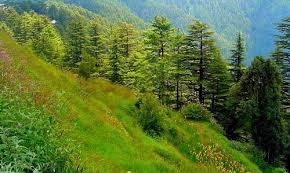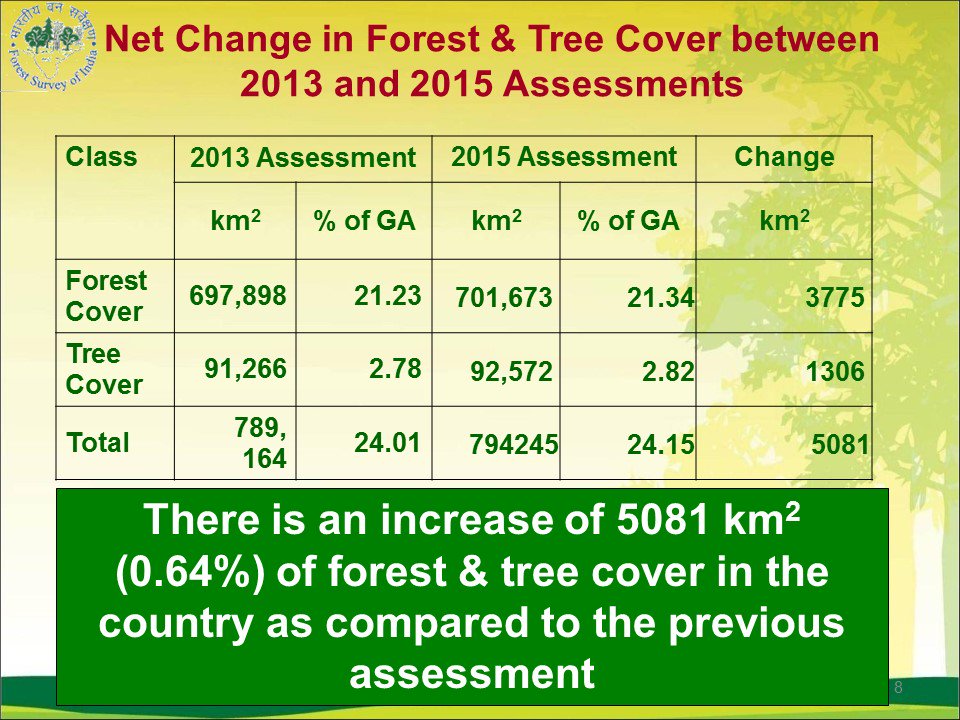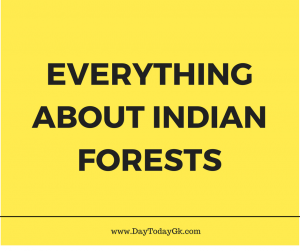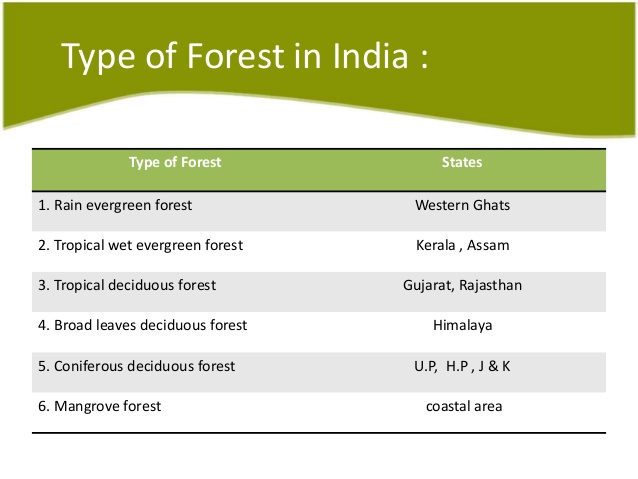indian forest
Forest covers of a geographical area include all lands having a tree density of 10 per cent and more and have a minimum area of one hectare.

India is one of the ten most forest-rich countries of the world along with the Russian Federation, Brazil, Canada, United States of America, China, the Democratic Republic of the Congo, Australia, Indonesia and Sudan. Together, India and these countries account for 67 percent of the total forest area of the world.
India’s forest cover grew at 0.22% annually over 1990-2000, and has grown at the rate of 0.46% per year over 2000-2010, after decades where forest degradation was a matter of serious concern.
What happened to Indian forest cover from 2013-2015??
- India’s total forest and tree cover has increased by 5081 sq km in the past two years, the latest Indian State of Forest Report (ISFR 2015), released by the Forest Survey of India (FSI).

The key facts of the report are as follows:
- Forest cover of the country as per this assessment is 701,673 sq. km which is 21.34 percent of the geographical area of the country.
- The tree cover of the country is estimated to be 92,572 sq. km which is 2.82 percent of the geographical area.
- The total forest and tree cover of the country as per this assessment is 794,245 sq. km which is 24.16 percent of the geographical area of the country.
- There is an increase of 3,775 sq. km in the forest cover of the country as compared to 2013 assessment.
- In hill and tribal districts of the country, there is a net increase of forest cover of 1,680 sq. km and 438 sq. km respectively as compared to the previous assessment.
- The North Eastern states of India account for one-fourth of the country’s forest cover. There is a net decline of 628 sq. km in forest cover as compared to the previous assessment.
- Mangroves cover has increased by 112 sq. km as compared to the previous assessment.
- The total carbon stock in the country’s forest is estimated to be 7,044 million tonnes, an increase of 103 million tonnes, which is an increase of 1.48 in percentage terms over the previous assessments.

Statewide Forest Cover Report 2015:-
- The maximum increase in forest cover has been observed in Tamil Nadu – 2,501 sq km, followed by Kerala – 1,317 sq km and Jammu & Kashmir – 450 sq km.
- Madhya Pradesh has the largest forest cover of 77,462 sq km in the country, followed by Arunachal Pradesh, with a forest cover of 67,248 sq km and Chhattisgarh – 55,586 sq km. Mizoram, with 88.93 percentage of forest cover has the highest forest cover in percentage terms, followed by Lakshadweep with 84.56 per cent.
- Out of these, 7 States/Union Territories – Mizoram, Lakshadweep, Andaman & Nicobar Island, Arunachal Pradesh, Nagaland, Meghalaya and Manipur have more than 75 per cent forest cover.
- Tripura, Goa, Sikkim, Kerala, Uttarakhand, Dadra & Nagar Haveli, Chhattisgarh and Assam have forest cover is between 33 percent to 75 percent.
 Indian Forest Act:-
Indian Forest Act:-
- The Indian Forest Act, 1927 was largely based on previous Indian Forest Acts implemented under the British.
- The most famous one was the Indian Forest Act of 1878. Both the 1878 act and 1927 one sought to consolidate and reserve the areas having forest cover, or significant wildlife, to regulate movement and transit of forest produce, and duty leviable on timber and other forest produce.
- It also defines the procedure to be followed for declaring an area to be a Reserved Forest, a Protected Forest or a Village Forest.
- It defines what is a forest offence, what are the acts prohibited inside a Reserved Forest, and penalties leviable on violation of the provisions of the Act.










